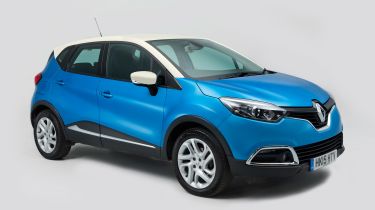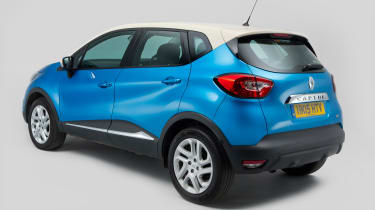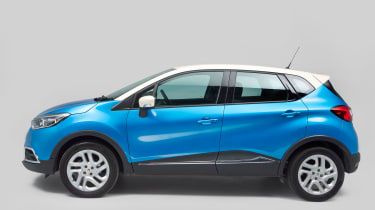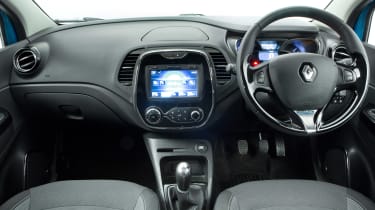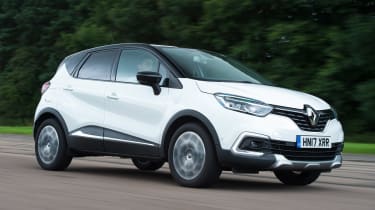Used Renault Captur (Mk1, 2013-2019) review
Stylish, spacious and cost-effective to run, the Renault Captur compact crossover is an attractive and hassle-free used car choice
Verdict
The first-generation Renault Captur proved to be one of the French manufacturer’s most popular models when it was new – and with good reason. Based on the same platform as the fourth-generation Clio supermini, the Captur is a compact crossover that sits higher and has more interior space than traditional small hatchbacks.
Sleek design helped it stand out from the crowd, as did personalisation options such as two-tone paint finishes. Inside it was surprisingly spacious, while features such as a sliding rear seat gave it extra family-friendly appeal. The quality of the interior trim wasn’t up to the best in the class, but it was well-equipped and comfortable.
As a used car, the Captur isn’t the most exciting thing to drive, but it’s competent, safe and rides bumps well. While controls such as the steering and gearbox lacked the finesse of rivals at the time, the engines scored for their smoothness and impressive efficiency.
Which one should I buy?
- Best Renault Captur for families: 1.3 TCe 130 Iconic
- Best Renault Captur for low costs: 1.5 dCi 90 Play
- Best Renault Captur for towing: 1.5 dCi 110 Dynamique Nav
The Captur reached UK showrooms in July 2013. Engines included 0.9-litre (TCe 90) and 1.2-litre (TCe 120) petrol units, or a 1.5-litre diesel (dCi 90). Initially there were Expression, Expression+, Dynamique Media Nav and Dynamique S Media Nav trim levels, but in October 2014, a range-topping Signature variant was added, available with all engines.
Used - available now

2021 Renault
Captur
20,272 milesManualPetrol1.0L
Cash £13,403
2013 Renault
Captur
34,713 milesAutomaticDiesel1.5L
Cash £10,200
2017 Renault
Captur
43,607 milesAutomaticDiesel1.5L
Cash £9,587
2021 Renault
Captur
43,063 milesManualPetrol1.0L
Cash £10,200At first, the dCi 90 came with a manual gearbox only; by October 2013, an automatic transmission was available, dubbed EDC (Efficient Dual Clutch).
In March 2015, a manual-only 108bhp version of the 1.5 dCi engine (dCi 110) was added to the range; eight months later the special-edition Iconic trim level arrived, with part-leather trim and a two-tone exterior colour scheme as standard. It was available with all engines.
Petrol engines are popular and will be the best option for most buyers, but don't ignore the diesels – they're good value. It's the same story with the EDC auto gearbox, which is decent and needn't put you off.
Expression trim features 16-inch alloy wheels, cruise control, Hill Start Assist, powered windows all round and electrically adjustable mirrors, but you have to move up to the Expression+ to get air-con. A two-tone colour scheme with contrasting roof colour and door mirror housings was also available on this trim level.
Dynamique MediaNav adds Bluetooth, climate control, 17-inch wheels, a seven-inch touchscreen display and cornering headlights. Dynamique S MediaNav adds rear parking sensors along with privacy glass and electrically folding door mirrors. Luxurious Signature spec gets leather trim, upgraded hi-fi and a rear parking camera.
In late 2017 the Captur was treated to a subtle facelift in order to help it stand out in an increasingly competitive sector. At the front it gained new LED-enhanced headlights and a reprofiled grille, while inside there was more standard equipment, including the addition of desirable driver safety aids such as autonomous emergency braking. The engine line-up was also tweaked, with the addition of the new 1.3-litre TCe 130 (128bhp) and TCe 150 (148bhp) petrols, the latter exclusively with the six-speed EDC automatic gearbox. At the same time the 108bhp dCi diesel was discontinued.
In 2018, Renault simplified the trim levels, with Play, Iconic, GT-Line and S Edition replacing the Expression, Dynamique Nav, Dynamique S and Signature models.
The original Captur was replaced by a second-generation version in 2019, which was a little larger and pushed the car upmarket. Featuring enhanced technology and a revitalised engine line-up, including a plug-in hybrid, this new model understandably attracts a premium over its predecessor
What are the alternatives?
You will often see the Renault Captur compared to the Nissan Juke. It's a decent alternative, but the Renault is the better car overall – it's roomier inside and better-equipped for similar money. The Juke's looks may appeal, though, while under the skin it shares its engines with the Captur, apart from the high performance Nismo versions.
Other Captur rivals include the Peugeot 2008, with its frugal engines, smart lines and practical interior. The Vauxhall Mokka of the same era is another option, because it’s decent value second-hand and has a spacious interior. But it’s disappointing to drive and not refined enough. You could also consider the Ford Ecosport, but we wouldn’t recommend it. While it’s reasonable to drive with decent engines, it looks and feels cheap inside and isn’t as comfortable as most rivals.
If you don’t necessarily want the rugged visual appeal of an SUV, then there are some accomplished traditional family hatchbacks to consider. Both the Ford Focus and VW Golf feel more grown-up on the move and feature a little more space inside, plus there’s a wider choice of engines. However, neither has the style, personalisation options or elevated driving position of the Captur.
Mazda CX-3 vs Renault Captur vs Nissan Juke
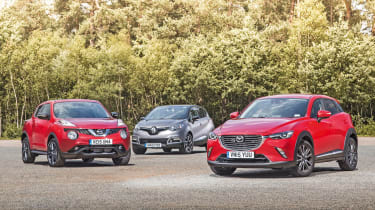
When the Captur met the then-new Mazda CX-3 and recently facelifted Nissan Juke in July 2015 it finished as a close runner-up. The Renault couldn’t match the Mazda’s engaging driving dynamics or high quality finish, but it was every bit as practical and had fractionally lower running costs. Both cars easily had the measure of the Nissan Juke, which was found to be cramped, uninspiring to drive and hobbled by a high asking price. Read the full test...
Renault Captur vs Citroen C4 Cactus
When we tested the revised Catur in September 2017 we praised its style, generous standard equipment and refined and responsive engine. Yet despite these strengths and a practical interior, the Renault had to give second best to the C4 Cactus, which was more characterful and comfortable, and featured a quirky design that helped it stand out even alongside the handsome Captur. Read the full test...
Ford Ecosport vs Renault Captur
There was no real contest when the Captur went head-to-head with the Ford Ecosport in September 2014. With its higher-quality finish, roomier interior, more grown-up driving dynamics, greater style and lower price, the Renault was the runaway winner. By contrast the Ecosport, developed and built by Ford’s Brazilian arm, was off the pace in almost all areas, even costing more to buy despite looking and feeling cheaper. Read the full test...
How much will a used Renault Captur cost?
The Captur was a great value choice when new, and it’s arguably an even better option as a used purchase. All the engine options are frugal and deliver affordable tax bills, while servicing and maintenance bills are similar to those of the similar era Clio supermini.
Prices
With the arrival of the all-new second-generation model in 2019, values of the original Captur softened slightly, making it an extremely attractive proposition for those looking for a stylish and well-equipped compact crossover that can also handle the rigours of family life.
Yet there’s also good news when you want to sell on, because while prices have been affected slightly by the new car, the original Captur still has a decent resale value. In fact, the ongoing popularity of SUVs means that it retains more of its value than the fourth-generation Clio it is based upon, despite being slightly more costly to run.
Better still, the Captur’s popularity means there are plenty of examples to choose from, so you can afford to be picky.
You can check the latest used prices for the Renault Captur on our find a car service, or use our free car valuation tool to research a specific model.
Fuel economy and emissions
All Captur models will be cost effective to run – none dip below 42mpg on claimed fuel economy and the CO2 emissions sit between 110 and 128g/km of CO2. The most efficient engine is the dCi 90 1.5-litre diesel, returning 51.4 to 53.3mpg regardless of gearbox choice and emitting 110g/km with a manual or 112g/km with an automatic ’box.
However, for most buyers the petrols will be efficient enough, with the 0.9-litre TCe 90 manual delivering between 44.1-45.6mpg according to the more realistic WLTP regulations and CO2 emissions at 122g/km.
It’s worth considering earlier models that were tested under the old NEDC fuel efficiency regulations because they will be even cheaper to run. Although real-world efficiency won’t be affected (the dCi 90 is rated at 78.5mpg but is mechanically identical to the 53.3mpg WLTP car) it’s official CO2 emissions of 95g/km mean you’ll pay nothing to tax it annually.
Running costs
All Capturs need to be serviced every 18,000 miles or 12 months. The schedule runs minor (£129), intermediate (£159), minor (£129) and major (£269), so the latter is required only every four years or 48,000 miles.
All engines have a cambelt which has to be replaced every six years or 90,000 miles at a cost of £399. The coolant should be renewed every five years or 90,000 miles (at a cost of £99), while fresh brake fluid is needed every three years or 72,000 miles (at £39).
The Captur was originally supplied with a three-year and 60,000-mile warranty, but from 1 January 2015 the cover was enhanced to four years with a 100,000-mile limit and breakdown recovery. This guarantee can be transferred between owners, which means later models will still be covered, so check the paperwork carefully.
What do owners think?
The Captur has had mixed results over the years in our Driver Power owner survey. It moved around in the top 50 for a few years but in 2021 it finished a creditable 37th out of 75 cars, which is impressive given the age of the design. Owners reserved particular praise for its comfort, ride quality and low running costs.
Reliability
Owners have also been pleased with the reliability of the Captur, rating it highly as a trouble-free purchase. This is hardly a surprise given it shares so many of its components with other cars in the Renault line-up, particularly the similar-era fourth-generation Clio supermini.
How practical is it?
The Captur will immediately appeal alongside conventional superminis as a family car because of its higher stance. This makes it easier to get in and out of, gives you a great view of the road ahead and means the boot is a bit easier to load.
It’s also more spacious than traditional small cars, such as the fourth-generation Renault Clio it’s based on, making the Captur an ideal stepping-stone between superminis and larger family hatchbacks or crossovers.
Dimensions, cabin and boot space
Despite being larger than Clio with which it shares its underpinnings, the Renault Captur remains a compact car. It is 4,127mm long, compared to the Clio’s 4,063mm, and is only 46mm wider at 1,778mm. The key jump is height: at 1,566mm tall, it is a full 118mm taller than the Clio, giving a more SUV-like stance and also seating occupants higher off the ground for a better view out.
The Renault makes very good use of these extra dimensions, particularly the additional height. It feels roomier than a Clio inside, yet is still usefully smaller than a traditional family hatchback – a Volkswagen Golf, for example, is well over 4.2 metres long and almost 1.8 metres wide.
The Captur feels more appealing to the Clio from behind the wheel, thanks to the extra confidence given by the higher-set seat. It’s not actually that much roomier, but it feels like it because of the seating position and more upmarket dash, especially the 2017 facelift versions. All models come with a steering wheel that adjusts for height and reach. Better still, the seat covers can be unzipped, allowing you to wash them if necessary or swap them for a different colour or fabric finish (leather was also available).
Naturally, given its extra height, headroom is fine. Rear legroom is better than in the Clio, and that’s hardly a cramped car, so the Captur scores well here overall.
All Captur models have a 60:40 split rear seat, which also slides back and forth so you can vary rear passenger legroom and boot space. With the seats up, the boot holds 377 litres, which compares very well with the Renault Clio that takes 300 litres. Slide that rear bench forward the full 160mm and the boot expands to 455 litres.
With the seats folded, there’s a flat floor and 1,235 litres of space, which Renault says is enough to swallow a full-size mountain bike with the front wheel removed. A split-level boot floor is also standard on all models for those who value easy slide-in access above overall space.
Even the door pockets are big: the front doors will store 1.5 litres and there are door bins in the rear doors that will swallow 0.5 litres. The stowage box on top of the dashboard holds 1.6 litres.
Equipment and technology
Entry-level Expression and Play models feature basic infotainment systems, with a radio, CD player and aux connection (although the later Play did at least have Bluetooth). As their name suggests, Nav models have in-built navigation accessed through Renault’s Media Nav seven-inch touchscreen. It’s a fairly basic system with low-resolution graphics and a rather fiddly menu system.
Much better is the similarly sized but better developed infotainment found on Dynamique and Signature models from 2017, and the Iconic trim level and from 2019 onwards. Featuring sharper graphics and a slicker operating system it also allows for better smartphone connectivity with Android Auto. Apple CarPlay was unavailable.
Expression misses out on air-conditioning, but gets alloy wheels, electric windows and cruise control. Of the pre-2019 cars, Dynamique models offer the best mix of value and kit, with touchscreen infotainment, climate control and keyless entry to name just a few desirable extras. The Signature and 2019 onwards S-Edition add lavish touches such as leather seat trim and a powerful stereo upgrade.
All Capturs come with a tyre inflation kit, while a spare wheel was an optional extra. Check in the boot to see if the car you’re interested in has one.
Safety
The Captur earned a five-star Euro NCAP crash safety score in 2013, scoring well for adult occupant protection and child protection. However, it’s worth bearing in mind that only post-2018 facelift models will have autonomous emergency braking as standard.
All Captur models come with Isofix child seat mountings on the front passenger seat and rear outermost seats, and there are child locks for the back doors, seatbelt warning indicators for all seats and whiplash-reducing, height-adjustable front headrests.
Renault also fitted its ‘Renault Anti-Intruder Device’ automatic door locking function to all Capturs. It secures the doors as you drive off, while on models with keyless entry the car automatically locks the car after you park up and walk away, meaning you’ll never leave it accidentally unlocked.
What’s it like to drive?
The Captur isn’t as fun to drive as similar-aged rivals, but it’s comfortable and hassle-free on the move. Compact dimensions make it easy to park, while the range of smooth turbocharged engines means it doesn’t feel out of its depth on the open road.
Engines
There are four petrol engines and two diesels in the Captur range. The 0.9-litre TCe 90 (89bhp) and 1.2-litre TCe 120 (118bhp) were available in early cars, while the 2017 facelift replaced this unit with the larger 1.3-litre TCe 130 (128bhp) and TCe150 (148bhp) versions. All these units are smooth and fairly responsive, although the entry-level TCe 90 needs to be worked hard to give its best; its 0-62mph time of 12.6 seconds is no worse than rivals’, though.
A five-speed manual transmission was standard across the range and it’s smooth and precise enough with a light clutch, which makes it easy to drive. The flagship TCe 150 was fitted with the six-speed EDC twin-clutch automatic transmission, which was optional on other models. It’s a great choice for around town, but it’s not as quick acting or as smooth as rival units, such as the DSG transmission in the SEAT Arona.
The diesel is the best choice if you plan to cover lots of long journeys, although the familiar 1.5 dCi is a little clattery by modern standards. It still performs well, with the dCi 90 capable of 0-62mph in 13.1 seconds, and can be extremely efficient, while the more powerful dCi 110 is worth seeking out for its extra mid-range muscle that makes for more effortless overtaking and a faster 0-62mph sprint of 11.4 seconds.
On the road
If you've driven a fourth-generation Clio, then the Captur is very familiar to drive because the two share the same platform, engines and mechanicals. Essentially Renault raised the ride height to create a better view of the road ahead and more ground clearance for that rugged SUV look.
Admittedly the Captur isn’t the most exciting car to drive, but it's easy and fairly smooth, suiting its positioning as an upmarket supermini alternative well – and also making it a viable grown-up competitor to more mainstream family hatchbacks.
While the Renault is pretty comfortable on most roads, poorer surfaces tend to upset the Captur, particularly when the chassis is already loaded up through a corner.
Where the Captur falls behind its small SUV rivals of the time (such as the Peugeot 2008 and Mazda CX-3) is the way it handles. Body roll is noticeable, the steering isn't very direct or feelsome and the gearshift is notchy and obstructive.
Indeed, the Captur feels like it’s made for the city; its raised height, good visibility, space-efficient interior and compact dimensions make it easy to understand why Renault dealers had no problem convincing upper-range Clio customers to make the switch.
One thing to note is that despite its tough off-roader looks, the Captur was never available with four-wheel drive. That said, pre-2017 models were available with the optional Grid Xtend feature, which combined switchable traction control with all-season tyres to make the Renault surprisingly capable off the beaten track.
What should you look out for?
Overall the Captur is a fairly robust and reliable machine and should give trouble-free running, assuming it's been regularly serviced. It should also be extremely cost effective to buy and run. However, there are some niggles to keep an eye out for.
Common used Mk1 Renault Captur problems
Radio silence
Issues with the DAB radio are not a rarity. The display can say that the system is on, but no stations are received so all you hear is silence.
Wheelarches
Some of the plastic finishing trims on the wheel arches can stand proud of the bodywork because they don’t fit properly.
Stop-start
The engine stop-start can work erratically, or not at all. Problems are often down to faulty sensors or a battery that’s failing to hold sufficient charge.
Recalls
The Captur has been recalled twice. In April 2015, 31,320 cars produced up to March that year had front wheel arch liners which were incorrectly positioned and could rub on the front brake hoses, causing damage. The resultant loss of brake fluid could lead to partial brake failure, but not a complete loss of power; a ‘Braking system fault’ warning would flash up on the dash. The answer was new hoses and to move the wheel arch liner.
A second recall occurred in 2018, but affected only 19 vehicles. It was to deal with an issue with the headlights failing to illuminate properly.
